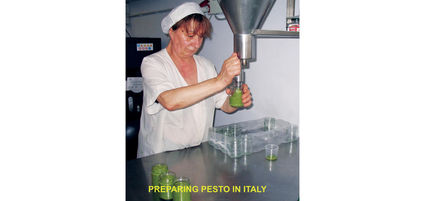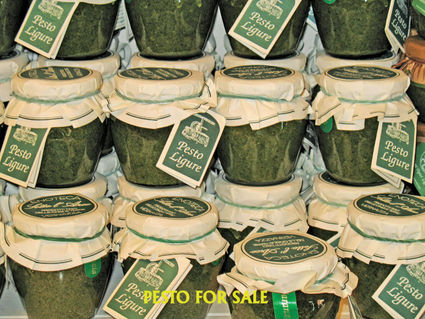Pesto or imposter?
Herb snips
August 31, 2019
What is pesto? I had been asked this question so many times that I began to look and listen attentively when the word was used. I knew what pesto was, having written a book about it. It is a delicious sauce made by combining basil, garlic, hard cheese, nuts and olive oil. I found out why it was so puzzling when I looked at recipes that had pesto in their name but basil was not an ingredient. For shame! They were imposter sauces taking the name pesto in vain. I was intrigued. I watched the chefs on the cooking channels. Surely they would be true to pesto. They made pastes from a variety of herbs and vegetables and they dared to call them all pesto. This left me confused.
Reviewing the history I was reminded that the Greeks, Romans and Italians used a version of basil pesto. It is said that Columbus would not leave port without it. This was true of many ship captains. The Genoan Pesto Purists are so serious about pesto that they have a standard recipe and procedure for making it. The basil and olive oil should be from Liguria, ingredients added in a particular order and blended with a mortar and pestle. With such an impressive history why did the adulteration of pesto occur?
In the U.S.A., I think the answer is that basil pesto has been Americanized by chefs to please their patrons and satisfy their creative urges. They use ingredients preferred in their region of the country. Cilantro in the South, rosemary in the North, parsley in the East and sage in the West. Recipes are shared in cookbooks, articles and on television. Since basil pesto is so popular and the name familiar, it has been usurped for all of these versions.
It is no wonder people are puzzled. They order pesto when dining out and find it does not have a single basil leaf in it. They look for pesto in their favorite store and find it is made without the expected basil. Even their favorite cookbooks may have a non-basil version of pesto.
What are we to do? It is not likely our protests will be heard or heeded outside of Italy. We can simply be informed and the truth will make us free to enjoy basil pesto and some of the tasty imposters. It will help if the cooks of America call their imposter pestos by another name. Sauce will do nicely!
I hope you enjoy these basil pesto recipes and the sauce imposters. After all, taste is what counts. This is the final of my four-part series on basil. If you missed any of the columns or wish to review them, please go to my website at http://www.herbbasket.net and click on The Loop.
• Choose Basil leaves that are unblemished with firm stems. Do not use woody stems. The Basil flowers may also be used and often intensify the flavor. • Gently rinse the Basil under cool water and dry it.
• Assemble the ingredients for the pesto recipe you have chosen and blend in a food processor.
See recipes and variations below, or use one of your own.
Ingredients:
• 2 cups basil leaves, flowers and very tender stems • 1/4 cup olive oil • 1/4 cup pine nuts
• 4 cloves garlic • 1/4 cup grated cheese (parmesan or romano) • 1/8 teaspoon black pepper
Directions:
Puree ingredients in a food processor. This pesto is dry and good for freezing.
Ingredients:
• 2 cups Basil • 1/8 cup fresh lemon juice or dry white wine • 4 cloves garlic
• 1/4 cup pine nuts • 1/4 cup grated cheese • 1/8 teaspoon pepper
Directions:
Blend together in a food processor. Add more liquid if the mixture appears too dry.
Ingredients:
• 2 cups fresh Lemon basil • 4 cloves garlic • 1/4 cup nuts (pine, almonds or walnuts)
• 1/4 cup grated cheese • 1/4 cup olive oil • Juice of one lemon
Directions:
Blend in a food processor. Add more juice if pesto is too dry.
Ingredients:
• 1/4 cup whole raw, unsalted almonds with skins
• 2 cups packed mint leaves, thick stems removed
• 1 cup packed flat leaf parsley leaves, thick stems removed
• 1/3 cup hot tap water • 1/4 cup olive oil • 2 teaspoons lemon juice • 1 teaspoon lemon zest
• 1 clove garlic, finely sliced (optional) • 1/4 teaspoon salt • Pinch of ground black pepper
Directions:
1. Toast the almonds: Preheat the oven to 350ºF. Spread the almonds on a baking sheet and toast in the oven for 8 to 10 minutes, or until they are fragrant. Remove from oven and let cool while you blanch the mint and parsley.
2. Blanch the mint and parsley: Bring a large saucepan of water to a boil. Set a bowl of ice water next to the stove.
Add the mint and parsley to the boiling water and leave it for 5 to 10 seconds, or just until they wilt. With a slotted spoon, transfer the herbs to the bowl of ice water. Swish them around for 30 seconds.
Drain into a colander, and with your hands, squeeze out as much liquid as possible.
3. Finish the pesto: In a food processor, combine the almonds, mint, parsley, hot tap water, olive oil, lemon juice, lemon zest, garlic (optional), salt and pepper. Pulse until finely chopped.
Then, set the processor on continuous speed and puree until creamy. If you like a slightly chunky pesto, stop the machine before it becomes smooth.
4. Season and store: Taste and add more salt and pepper if you like. Transfer to a glass jar and store in the refrigerator for up to 5 days. Freeze in ice cube trays for up to 12 months.
Ingredients:
• 2 cups, packed, of cilantro, including stems • 1/2 cup blanched almonds
• 1/4 cup chopped red onion • 1/2 teaspoon chopped and seeded serrano chile
• 1 teaspoon Kosher salt • 1/4 cup extra virgin olive oil
Directions:
1. Toast the almonds: Heat a small skillet on high heat. When the pan is hot, add the blanched almonds in a single layer. Stir with a wooden spoon. When the almonds are fragrant and start to brown, remove them from the pan.
2. In a food processor, pulse the cilantro, almonds, onion, chile, and salt until well blended.
3. Slowly add the oil: With the food processor running, slowly add the olive oil in a steady stream. Add more oil as needed for your use.
Whatever you don't use, you can freeze. Line a ice cube tray with plastic wrap and fill in the individual cube spaces with the pesto. Freeze and remove from the ice tray, put in a sealed freezer bag for future use.






